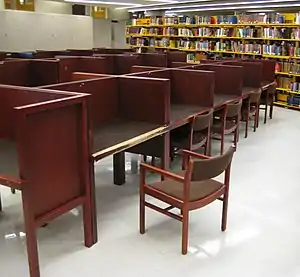Carrel desk
A carrel desk is a desk, often found in libraries, with partitions at back and sides to provide privacy.[1]

Description
Carrel desks are especially common in academic libraries.[2] Sometimes the seat is integrated with the carrel desk. They may also have a shelf, built-in illumination, electrical outlets, or Ethernet ports.[1] Unlike the cubicle desk, carrel desks usually have no file drawers or other facilities. They are designed to stand alone or to be grouped together, with or without common sides or walls.
The word carrel may also refer to a small, isolated "study room" in public libraries and on university campuses;[1] the room may have a lockable door, to which the user is granted the key on request. Carrels typically contain a desk (not necessarily one described as above), shelving and a lamp.[1]
Origins
Carrels originated in monasteries to help contain the cacophony of roomfuls of monks reading aloud, as was the early practice.[3] Carrels are first recorded in the 13th century at Westminster Abbey, London, on the Garth side of the North Walk, though they probably existed from the late years of the 12th century.[4][5]
See also
References
- Joan M. Reitz (2004). Dictionary for library and information science. Libraries Unlimited. p. 118. ISBN 1-56308-962-9.
- Aaron Coben; Elaine Coban (1979). Designing and space planning for libraries : a behavioral guide. R. R. Bowker Co.
- Jean LeClerq, Love of Learning and the Desire for God, trans. Catherine Misrahi (New York: Fordham University Press, 1961) p. 18
- Pratt, Helen Marshall (1914). Westminster Abbey: Its Architecture, History and Monuments. Vol. 2. New York: Duffield and Company. p. 698.
- "carrel". Encyclopædia Britannica. Retrieved 4 January 2021.